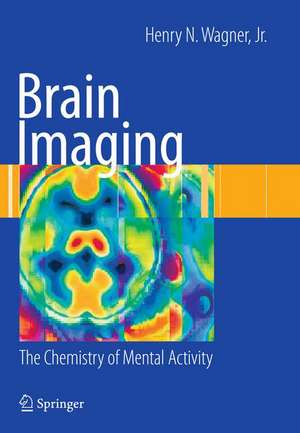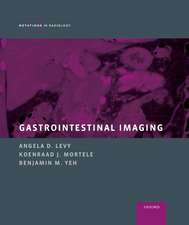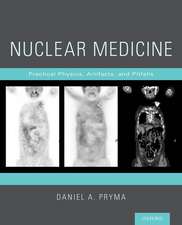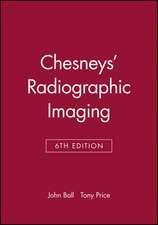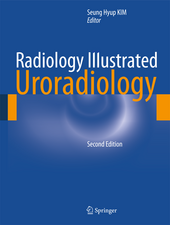Brain Imaging: The Chemistry of Mental Activity
Autor Henry N. Wagneren Limba Engleză Paperback – 17 noi 2009
The book reviews all the results of PET and PET/CT imaging of the brain with all radiopharmaceuticals that bind to receptors in all recognized and classified mental diseases, as well as the studies on the localization of those sites that are activated by sensory or motor activity. The book illustrates the parts of the brain activated and deactivated during sensory perception, motion and other mental functions and explains how the process of neurotransmission takes place in chemical terms.
The book is a valuable reference resource for all those in nuclear medicine and radiology as well as the educated general public.
| Toate formatele și edițiile | Preț | Express |
|---|---|---|
| Paperback (1) | 372.97 lei 43-57 zile | |
| SPRINGER LONDON – 17 noi 2009 | 372.97 lei 43-57 zile | |
| Hardback (1) | 672.05 lei 38-44 zile | |
| SPRINGER LONDON – 16 ian 2009 | 672.05 lei 38-44 zile |
Preț: 372.97 lei
Preț vechi: 392.60 lei
-5% Nou
Puncte Express: 559
Preț estimativ în valută:
71.39€ • 77.57$ • 60.01£
71.39€ • 77.57$ • 60.01£
Carte tipărită la comandă
Livrare economică 21 aprilie-05 mai
Preluare comenzi: 021 569.72.76
Specificații
ISBN-13: 9781848829220
ISBN-10: 1848829221
Pagini: 260
Ilustrații: XIV, 246 p. 29 illus., 25 illus. in color.
Dimensiuni: 178 x 254 x 13 mm
Greutate: 0.52 kg
Ediția:2009
Editura: SPRINGER LONDON
Colecția Springer
Locul publicării:London, United Kingdom
ISBN-10: 1848829221
Pagini: 260
Ilustrații: XIV, 246 p. 29 illus., 25 illus. in color.
Dimensiuni: 178 x 254 x 13 mm
Greutate: 0.52 kg
Ediția:2009
Editura: SPRINGER LONDON
Colecția Springer
Locul publicării:London, United Kingdom
Public țintă
Professional/practitionerCuprins
A Molecular Theory of Disease.- The Master Molecule.- Genes and Disease.- From Brain to Mind.- The Early Days.- A Molecular Theory of Mental Disease.- The Physics of Radioactivity.- The Tracer Principle.- Aggression vs Altruism.- Monitoring Mental Activity.- Violence and Crime.- Drug Design and Development.- Substance Abuse.- Mental Illness.- The Hormone of Love.- The Golden Rule.- Brain Dysfunction in Children.- Brain Dysfunction in Adults.- Conclusion.
Recenzii
From the reviews:
"The book, which is actually a compilation of the author’s insights into brain chemistry and the potential implications for understanding human nature, is a distinctive contribution to the field. The purpose is to ‘bring to date all the exciting work present in brain imaging, showing the differences among imaging modalities, and reviewing the knowledge of chemical reactions in the brain.’ … The intended audience is suggested to be ‘both professionals and the public.’ … you’re on your own if you read this book." (Michael J. Schrift, Doody’s Review Service, April, 2009)
"This interesting book first explains the technical and scientific details of molecular neuroimaging and then links to the clinical aspects of neurologic and mental disorders. … Imagers, neuroscientists, and the general public will benefit from reading it. … The 19 chapters are well referenced and logically arranged. … It is definitely well worth reading … ." (Franklin C. Wong, The Journal of Nuclear Medicine, Vol. 50 (11), November, 2009)
“This well-structured publication is actually a collection of insights into brain chemistry and the potential implications this has on human nature. The book is divided into 19 chapters and … is based on the premise that a mental illness can be explained as a molecular disease. … a valuable reference resource for medical specialists and students in nuclear medicine, radiology, neurology, neuropsychiatry or for scientists involved in neuro-research. … stimulate cultural interest for non-specialists, including an educated general public of readers interested in scientific literature.” (F. Coppola and L. Mansi, European Journal of Nuclear Molecular Imaging, Vol. 38, 2011)
"The book, which is actually a compilation of the author’s insights into brain chemistry and the potential implications for understanding human nature, is a distinctive contribution to the field. The purpose is to ‘bring to date all the exciting work present in brain imaging, showing the differences among imaging modalities, and reviewing the knowledge of chemical reactions in the brain.’ … The intended audience is suggested to be ‘both professionals and the public.’ … you’re on your own if you read this book." (Michael J. Schrift, Doody’s Review Service, April, 2009)
"This interesting book first explains the technical and scientific details of molecular neuroimaging and then links to the clinical aspects of neurologic and mental disorders. … Imagers, neuroscientists, and the general public will benefit from reading it. … The 19 chapters are well referenced and logically arranged. … It is definitely well worth reading … ." (Franklin C. Wong, The Journal of Nuclear Medicine, Vol. 50 (11), November, 2009)
“This well-structured publication is actually a collection of insights into brain chemistry and the potential implications this has on human nature. The book is divided into 19 chapters and … is based on the premise that a mental illness can be explained as a molecular disease. … a valuable reference resource for medical specialists and students in nuclear medicine, radiology, neurology, neuropsychiatry or for scientists involved in neuro-research. … stimulate cultural interest for non-specialists, including an educated general public of readers interested in scientific literature.” (F. Coppola and L. Mansi, European Journal of Nuclear Molecular Imaging, Vol. 38, 2011)
Notă biografică
A pioneer in nuclear medicine and past president of the Society of Nuclear Medicine, Professor Henry N. Wagner Jr., MD has spent nearly five decades helping to define and promote the specialty. His groundbreaking work in the applications of nuclear medicine to pulmonary and coronary artery disease and his studies of brain chemistry with radio-labelled tracers have led to significant advances in these fields. Wagner is the director of the Division of Radiation Health Sciences at Johns Hopkins University in Baltimore, where he has worked since 1958. He is a professor emeritus of radiology and radiological sciences at the Johns Hopkins School of Medicine and a professor of environmental health sciences at the School of Hygiene and Public Health. A prolific researcher and writer, Wagner is author or co-author of more than 800 publications, including peer-reviewed journal articles, books and chapters. He is a member of several editorial boards and many medical and radiological societies, and an honorary member of the British Institute of Radiology (2000).
Textul de pe ultima copertă
Taking both a historical and philosophical stance, Brain Imaging: The Chemistry of Mental Activity provides a detailed account of molecular imaging at its finest. Written by Dr. Henry N. Wagner Jr, a highly acclaimed author and international authority in the field of nuclear medicine, the book brings to date all the exciting work present in brain imaging, showing the differences among the various imaging modalities, and reviewing the knowledge of chemical reactions in the brain.
Suitable for both professionals and the public alike; this book spans basic principles through to historical and current uses of molecular imaging. The vast utility of imaging is highlighted by examining common themes and topics prominent in human life; love, aggression, altruism, violence, crime, and substance abuse to name a few.
Dr. Henry N. Wagner Jr, a pioneer in nuclear medicine, has made groundbreaking contributions to advancing the fields of radiology and nuclear medicine, namely in the areas of brain physiology and pathophysiology, and addiction and drug design. He is a member of the Institute of Medicine of the US National Academy of Sciences, as well as several editorial boards and many other medical and radiological societies, and is an honorary member of the British Institute of Radiology (2000). During his time at the John Hopkins University he has trained more than 500 radiologists, internists, physicians, and scientists, eight of whom have held, as he has, the position of President of the Society of Nuclear Medicine. In 1985 he was awarded the Georg Von Hevesy Award and in 1993 Dr. Wagner was awarded the first Annual Society of Nuclear Medicine President’s Award for Outstanding Contributions to nuclear medicine.
Suitable for both professionals and the public alike; this book spans basic principles through to historical and current uses of molecular imaging. The vast utility of imaging is highlighted by examining common themes and topics prominent in human life; love, aggression, altruism, violence, crime, and substance abuse to name a few.
Dr. Henry N. Wagner Jr, a pioneer in nuclear medicine, has made groundbreaking contributions to advancing the fields of radiology and nuclear medicine, namely in the areas of brain physiology and pathophysiology, and addiction and drug design. He is a member of the Institute of Medicine of the US National Academy of Sciences, as well as several editorial boards and many other medical and radiological societies, and is an honorary member of the British Institute of Radiology (2000). During his time at the John Hopkins University he has trained more than 500 radiologists, internists, physicians, and scientists, eight of whom have held, as he has, the position of President of the Society of Nuclear Medicine. In 1985 he was awarded the Georg Von Hevesy Award and in 1993 Dr. Wagner was awarded the first Annual Society of Nuclear Medicine President’s Award for Outstanding Contributions to nuclear medicine.
Caracteristici
Acquaints the reader with awareness of all the chemical reactions going on in his/her brain at all times, and how drugs affect these processes Includes supplementary material: sn.pub/extras
